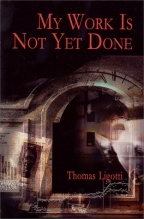My Work Is Not Yet Done
Thomas Ligotti
Mythos Books
US First hardcover
ISBN 0-965-94337-2
Publication Date: 06-01-2002
200 Pages; $30.00
Date Reviewed: 03-31-03
Reviewed by Rick Kleffel © 2003

REFERENCES
COLUMNS
|
|
|
My Work Is Not Yet DoneThomas LigottiMythos BooksUS First hardcoverISBN 0-965-94337-2Publication Date: 06-01-2002200 Pages; $30.00Date Reviewed: 03-31-03Reviewed by Rick Kleffel © 2003 |
|
|
REFERENCES |
COLUMNS |
Surprisingly enough, though we live in a time when unemployment is high, and employment itself is as necessary as food or water (it's necessary to be able to afford food or water), few writers of speculative fiction are treating this vital theme. Thomas Ligotti is known as a writer of grotesque, gothic horror, rather abstract and trending towards literary. His own work is highly regarded and doesn't seem to come often enough. Thus far, all his work has been short stories, collected in 'Songs of a Dead Dreamer', 'Grimscribe', 'Noctuary' and 'The Nightmare Factory'. 'Songs of a Dead Dreamer', in the original edition illustrated by Harry O. Morris is a genuine collector's item, rarely on the market for very long. Ligotti's latest title, 'My Work Is Not Yet Done' features the title novel and two shorter, somewhat related works, and a cover by Harry O. Morris. Everything you get in this Mythos book, from cover to close, is top notch. You'll want more.
More is slow to come from Ligotti, and reading 'My Work Is Not Yet Done', you can see why. The title novel is one part Kafka, one part Columbine and one part 'Sixth Sense'. And though those may seem like confining boundaries, Ligotti's novel is nothing if not wholly original and unusual even for Ligotti. 'My Work Is Not Yet Done' tells the story of Frank Dominio, a middle manager in a monolithic corporate entity. "I have always been afraid," the book begins. Ligotti nails the combination of rage and terror that so many trapped in unpleasant and unfulfilling jobs experience on a daily basis. Dominio is betrayed by his boss, and driven to violence, when something intercedes and he achieves a whole new level of understanding.
Ligotti is equally at home humorously describing the quirks of being trapped in corporate capitalism or in the fleshy tombs that carry our blighted souls. It's not for nothing that this work is subtitled 'Three Tales of Corporate Horror', and the word is used in both senses. Though his tone is rather different than the tone readers have encountered in his previous works, Ligotti still achieves the same cosmic splendor at the end of his long workday. As a novel, 'My Work Is Not Yet Done' may leave some reader scratching their head. At first, it appears to be heading nowhere fast, and when it gets somewhere, those same readers will find themselves wondering what and why. But those who love Ligotti will rejoice in his ability to morph his style but retain his power. In the end readers who stick around will find that Ligotti is indeed writing a very cleverly constructed novel, not just a long string of weirdness.
'My Work Is Not Yet Done' is followed by two shorter works, 'I Have A Special Plan For This World' and 'The Nightmare Network'. 'I Have A Special Plan For This World' hinges somewhere out past the end of the first story, though the connection is vague at best, in the best fashion of Ligotti's professional evocation of vague. For those who have worked for large corporations where the top boss is mostly a rumor or a headline in the business pages, Ligotti evokes a mystic feeling of being connected to something impossibly huge and possibly evil. 'The Nightmare Network' is Ligotti's first verifiable piece of literary science fiction, a series of evolving prose poems set in the far future of the two preceding pieces.
Throughout this work, Ligotti's sense of humor keeps readers enjoyment high while simultaneously helping to crush their hopes. Few have Ligotti's mastery of humor and horror and his ability to pair them up like a man with his nose to the mirror. The cover image by Harry Morris is gorgeous, and the interior illustration is eerily frightening. However, as much as I usually dislike dust jacket notes, I find their absence on this book somewhat flustering. And, since Frank Dominio is an amateur photographer, who specializes in taking photos of empty buildings and abandoned lots, the opportunity for Mythos to put out a more thoroughly illustrated edition seems obvious. Everything that is here is top rate. But there could have been so much more. Effective DJ notes, and about thirty more B&W collages from Morris would have made this book a classic volume to own. Have no doubt, it's definitely worth owning. But reading Ligotti's work tends to make one think about what's in -- or not in -- the dark spaces between things of this world, even if they are the pages of the book you're reading.